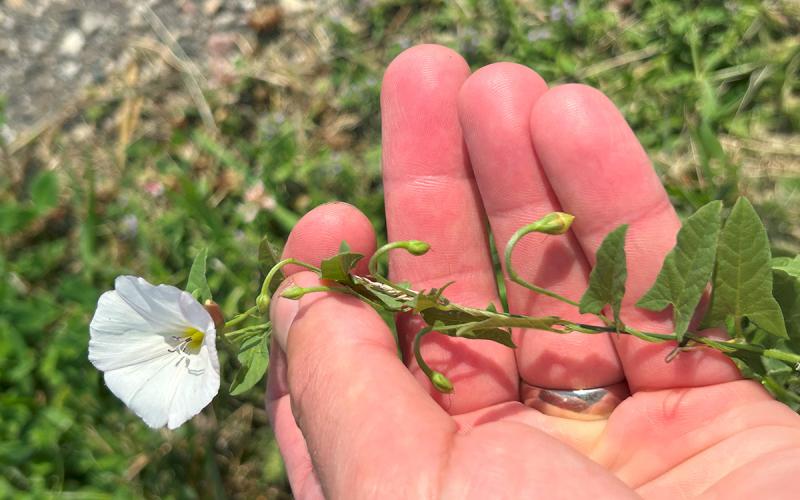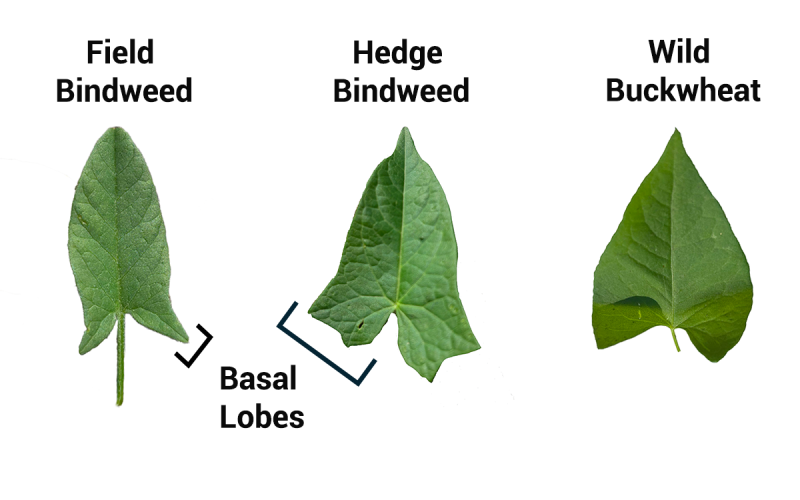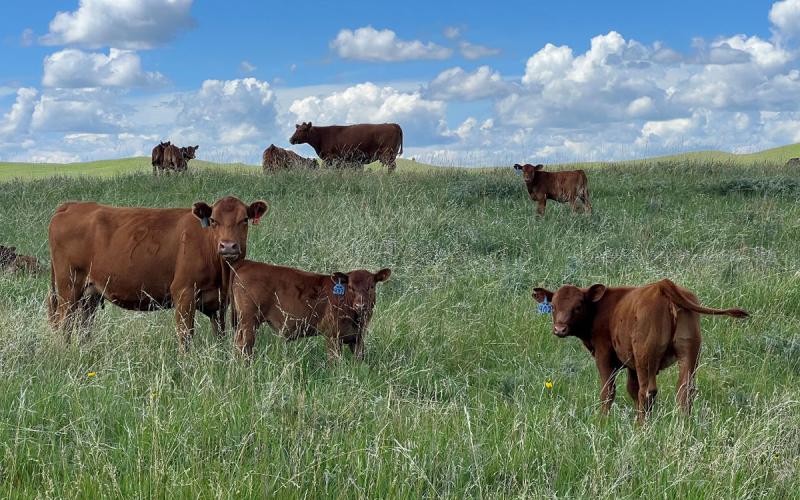
It’s August and field bindweed (Figures 1 and Figure 2), one of our most-persistent perennial weeds, is flowering. Although not statewide noxious, it’s locally noxious in Bennett, Bon Homme, Clarke, Lake, Stanley, and Yankton counties. Therefore, it’s the landowner’s legal responsibility to control the weed in these counties.
Identification and Management
Field bindweed can sometimes be mistaken for hedge bindweed and wild buckwheat (Figure 2). However, the basal lobes of field bindweed leaves are more pointed, whereas those of hedge bindweed are more angular or “squared off.” Both bindweed species are perennials, but wild buckwheat is an annual with leaves that are heart shaped. Wild buckwheat is typically found in annual production systems such as crop fields and vegetable gardens. Bindweed species are found in both annual and perennial systems (i.e. lawns or grasslands).

Often called Creeping Jenny, one must kill its extensive root system to control the weed. Hand-pulling the above ground foliage, which produces the plant’s resources, can starve the roots. This must be done persistently over several years. Mowing is not a substitute for pulling, as it doesn’t cut the weed at the soil surface. In addition, field bindweed can adapt and produce seed below the mowing height. Shallow tillage (2-4 in. depth) can also be effective. Similar to hand-pulling, tillage needs to be persistent over several years but can lead to increased soil erosion. Field bindweed lacks shade tolerance, so growing a thick canopy of a taller species, spreading mulch, or tarping the soil surface are also good control measures.
Herbicide Considerations
Lawns
Early fall herbicide applications typically provide the best control, as the weed sends more resources to the root to prepare for winter survival. Translocated active ingredients, such as those belonging to the synthetic auxin family (2,4-D, dicamba, quinclorac, mecoprop, MCPA), are more likely to move to the roots with these resources during this time. One drawback of early fall applications is that field bindweed typically produces seed before this time. Herbicide blends containing quinclorac are often applied to lawns for crabgrass control in August. In addition to quinclorac, these blends usually contain 2,4-D and dicamba. All three of these active ingredients can control field bindweed. When making an August application to control crabgrass and field bindweed at the same time, evaluate the effectiveness and make a second application during early fall if necessary. Read the label to determine the appropriate interval between applications, which is usually 14 to 30 days depending on the product.
Rangeland, Pastures, Conservation Reserved Program (CRP), and Fallow
The same active ingredients used to control this weed in lawns (2,4-D, dicamba, and quinclorac) can also be used in non-lawn settings. However, the product trade name often differs for what’s legal in one setting vs. another. For example, Facet® L and Quintessential® both contain 1.5 lbs. quinclorac per gal. of product. Facet® L is legal for use in pasture, rangeland, CRP, and fallow, but not lawns. Quintessential® is legal for use in lawns, but not pasture, rangeland, CRP and fallow. Picloram (Tordon®) is another option for most non-lawn settings. Products containing picloram are restricted use pesticides and require proper licensing to purchase and apply. Picloram + 2,4-D (Grazon® P+D, Gunslinger® P+D, GrazonPD3TM) is especially effective against field bindweed.
Always pay attention to the rotational intervals for the product you’re choosing. This is the amount of time required until planting the next crop following application of the product. Some herbicides may require a specific number of months or completion of a bioassay, which is a soil test to determine if herbicide remains in the soil that may injure the next crop. Also pay attention to haying, slaughter, and dairying restrictions. Some herbicides state that lactating dairy animals can’t be grazed for 7 days after application, that hay can’t be harvested for 30 days after application, and/or that animals must be removed from treated forage at least 3 days before slaughter.

